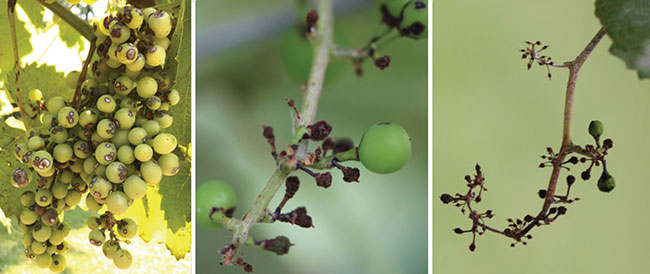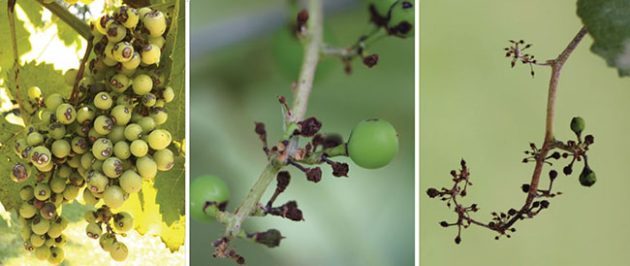
Features
Diseases
Fruit
Disease deep-dive: Anthracnose on grapevines
Reducing infected plant material and sources of inoculum in your vineyard will reduce future anthracnose infections.
April 25, 2022 By Sajid Rehman (Perennia) & Shawkat Ali (AAFC)
 Photos courtesy of Texas A&M Agriculture and Life Sciences.
Photos courtesy of Texas A&M Agriculture and Life Sciences. Anthracnose, or black spot, of grapevine is also known as bird’s-eye rot and is caused by the fungal pathogen Elsinoe ampelina. Under the warm and humid growing conditions of eastern North America, anthracnose can cause significant damage to grapevines by destroying new shoots, leaves, petioles, tendrils and berries, lowering fruit quality and yield.
Symptoms
Leaves: Initially, small, circular brown spots of variable diameter (one to five millimetres) appear; with age, their centres turn greyish with dark brown to black margins (figure 1A). Older lesions on the leaves may have circular or angular margins, but their necrotic centres generally drop out to depict a “shot-hole appearance” (figure 1B). These lesions may coalesce and cover the entire leaf blade, followed by the death of the infected leaf. Infected young leaves at shoot tips are malformed and appear burned, as the lesions prevent their normal development (figure 1C).
Shoots:The infection on young shoots starts as small, reddish-brown, circular lesions. Later, these lesions appear sunken with greyish centres and dark-brown circular or angular margins (figure 2A). The margins of the lesions may appear raised and their centres may expand up to shoot’s pith. Under warm and humid weather, small, pink spore masses can be observed in the lesions. Later, these individual lesions coalesce and the blighted shoot may crack (figures 2B and 2C), which is why the infected shoot remains stunted in growth and leads to the deterioration of older canes. Similar symptoms can be observed on petioles and tendrils.

Figure 2. Anthracnose infections on shoots. (left) Small, reddish brown, and circular lesions Photos Courtesy of Texas A&M Agriculture and Life Sciences. (centre) Older lesions with a flaky appearance, (right) Crack on a blighted shoot Photos Courtesy of Agriculture and Food, Western Australia.
Anthracnose lesions on the shoots may look similar to hail injury, but anthracnose lesions have raised, dark-brown edges. In addition, hail damage is mostly observed on one side of the shoot, whereas anthracnose lesions are more evenly distributed.
Berries: The lesions on rachis and pedicels resemble those observed on petioles and shoots. The girdling on rachis leads to shrivelling and drying of the entire cluster. Infected berries develop small, reddish-brown, circular sunken spots with a diameter of 5 to 7 mm. The centers of these sunken spots become whitish-grey with reddish-brown to black margins which resemble a bird’s eye (figure 3A). These lesions on berries may enter into the pulp, followed by cracking and invasion of secondary micro-organisms, which leads to sour rot that deteriorates the quality of extracted juice. Severely infected berries look mummified due to shrivelling and drying (figures 3B and 3C).

Figure 3. (Left) Bird’s eye spot on developing berries,;(centre) mummified berries with girdled pedicel and (right) rachis. Photos courtesy of Texas A&M Agriculture and Life Sciences.
Epidemiology
The pathogen can overwinter on diseased canes and berries from previous growing season which were left either on the vine or the vineyard floor. Fungal resting structures (mycelium or sclerotia) are activated and start producing conidia in early spring following a wetness period of 24 hours at a temperature of 2 C. The rain splashes disseminate freshly produced conidia to newly growing tissues, where primary infection can be initiated depending upon temperature (2 to 32 C) and wetness period. Warmer temperature reduces the wetness period required for starting a primary infection and the subsequent symptom expression. Under optimum temperature of 25 to 30 C, spore germination requires only three to four hours of wetness period, followed by symptom expression within three to four days under the same temperature range. By contrast, under lower temperature, symptom expression is delayed.
Lesions developed on new leaves, shoots, tendrils and young berries produce abundant mucilaginous conidia under humid weather, which are dislodged and disseminated by rain droplets to a shorter distance (up to seven metres). Disease development and further spread is stopped in the latter half of summer, depending on the onset of the dry period.
Management
The infected canes and mummified berries left either on the vines or on the orchard floor are the primary sources of initial inoculum. Infected canes should be pruned out and destroyed in the winter before any new buds appear on vines. Similarly, infected fallen berries on the vineyard floor should be ploughed and covered with soil or mulch. This practice will significantly reduce the release and spread of spores.
Some commercial grape varieties are highly susceptible to anthracnose infection. These include Thompson Seedless, Cardinal, Delicia, Italia, Citronella, Queen of Vineyards, Vidal Blanc (hybrid) and seedless table grape varieties (especially Reliance). Highly susceptible varieties should not be planted in heavy soils because these growing conditions favour anthracnose development.
Depending on rainfall events, vineyards with a known history of disease should apply recommended foliar fungicides at seven- to 14-day intervals starting from shoot lengths of about 5 to 10 cm until the berries are half grown. Late dormant-season sprays, shortly after bud break, may inhibit germination of sclerotia and spread of primary conidial spores from infected canes. Bordeaux mixture and copper oxychloride may be used to protect against anthracnose.
Scouting
Vineyards should be monitored regularly from early May to mid-September, with more frequent scouting from June to August.
When: From phenological stage 3 (first leaf unfolded to four to six leaves unfolded) to stage 12 (inflorescence visible). Regular monitoring should continue until harvest under prolonged wetness periods, especially after rainfall and storm events.
Where: Throughout the vineyard.
How: Monitor young leaves for the appearance of small brown spots (1 to 5 mm in diameter), with greyish centres and dark brown to black margins.
Print this page